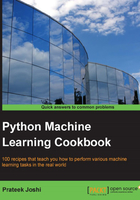
上QQ阅读APP看书,第一时间看更新
Extracting learning curves
Learning curves help us understand how the size of our training dataset influences the machine learning model. This is very useful when you have to deal with computational constraints. Let's go ahead and plot the learning curves by varying the size of our training dataset.
How to do it…
- Add the following code to the same Python file, as in the previous recipe:
# Learning curves from sklearn.learning_curve import learning_curve classifier = RandomForestClassifier(random_state=7) parameter_grid = np.array([200, 500, 800, 1100]) train_sizes, train_scores, validation_scores = learning_curve(classifier, X, y, train_sizes=parameter_grid, cv=5) print "\n##### LEARNING CURVES #####" print "\nTraining scores:\n", train_scores print "\nValidation scores:\n", validation_scoresWe want to evaluate the performance metrics using training datasets of size 200, 500, 800, and 1100. We use five-fold cross-validation, as specified by the
cvparameter in thelearning_curvemethod. - If you run this code, you will get the following output on the Terminal:

- Let's plot it:
# Plot the curve plt.figure() plt.plot(parameter_grid, 100*np.average(train_scores, axis=1), color='black') plt.title('Learning curve') plt.xlabel('Number of training samples') plt.ylabel('Accuracy') plt.show() - Here is the output figure:

Although smaller training sets seem to give better accuracy, they are prone to overfitting. If we choose a bigger training dataset, it consumes more resources. Therefore, we need to make a trade-off here to pick the right size of the training dataset.